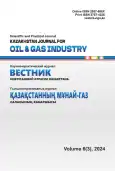«Газпром мұнай» компаниялар тобы кен орындарында қабатты сумен жару карбонатты объектілерді игеру тәжірибесі
- Авторлар: Пичугин М.Н.1, Чураков А.В.1, Кряжев А.В.1, Дотков Ю.Н.1
-
Мекемелер:
- «Газпром мұнай» компаниялар тобы
- Шығарылым: Том 6, № 3 (2024)
- Беттер: 48-58
- Бөлім: Oil and gas field development and exploitation
- URL: https://journal-vniispk.ru/2707-4226/article/view/266872
- DOI: https://doi.org/10.54859/kjogi108721
- ID: 266872
Дәйексөз келтіру
Толық мәтін
Аннотация
Қабатты гидравликалық жару (бұдан әрі – ҚГЖ) арқылы карбонатты объектілерді әзірлеу өте қызықты және бір мәнді емес процесс. Терригендік объектілерден айырмашылығы, қабатты ынталандыруды қышқылмен де, проппантты әдіспен де жасауға болады, ал технологиялық тармақтардың көптігі таңдау опцияларын одан әрі кеңейтеді. Объектінің геологиялық және физикалық сипаттамаларына байланысты ҚГЖ технологиясын таңдаудың жалпы тұжырымдамасы болғанына қарамастан, сапалы таңдау күрделене түседі, өйткені бір объектіде нәтиже беретін шешімдер екіншісінде ұқсас жағдайларда бірдей тиімділікті көрсетпейді. Сондықтан, карбонаттармен жұмыс істеу тұрғысынан алғанда, ынталандыру тәсілі мен технологиясын таңдауға байланысты өндірістік тәуекелдер мен шығындарды азайту үшін әртүрлі ұңғымалық жағдайларда мүмкіндігінше көп тәжірибеге ие болу маңызды.
Мақалада ұңғымалық және геологиялық жағдайларға байланысты олардың ерекшеліктері мен қолданылуын түсінуге бағытталған карбонатты объектілерге арналған ҚГЖ саласындағы тиімді шешімдерге технологиялық шолуды көрсету міндеті қойылған. Авторлар «Газпром мұнай» компаниясының периметріндегі карбонатты нысандарда орын тапқан және өзін дәлелдеген ынталандыру технологияларын қолдану тәжірибесін таратуға, белгілі бір шешімді таңдау кезінде кездесетін тәуекелдер мен шектеулерді көрсетуге маңызды орын береді. Карбонатты объектінің геологиялық жағдайларына байланысты ҚГЖ және ҚГЖ-дағы тәжірибе, технологиялар, тәсілдер және олардың ерекшеліктері сипатталған. Жұмыста карбонатты объектілерде ҚГЖ технологияларын қолданудың нақты тәжірибесі, олардың салыстырмалы тиімділігі, орындалған жұмыстың нақты тәжірибесіне сүйене отырып, ең табысты тәжірибелер көрсетілген. Қышқыл ҚГЖ, қышқыл-проппантты ҚГЖ технологияларының тиімділігін және қышқыл құрамындағы қышқыл ҚГЖ вариацияларын салыстыруға көп көңіл бөлінеді.
Жұмыс нәтижелері карбонатты объектілерді ҚГЖ әдісімен ынталандырудың технологиялық әртүрлілігі туралы түсінік беріп қана қоймай, сонымен қатар коллектордың пайда болуының белгілі бір геологиялық-физикалық жағдайында олардың салыстырмалы тиімділігін көрсетеді. Көрсетілген тәжірибе құрылымы жағынан ұқсас объектілерді игеру кезінде тиімдірек шешімдерді таңдауға, ҚГЖ орындауға дайындықтың алғашқы кезеңдерінде тәуекелдерді азайтуға және ынталандыру технологиясын таңдауда анықтауға, сол арқылы кен орындарын игерудің сапасы мен тиімділігін арттыруға көмектеседі.
Толық мәтін
##article.viewOnOriginalSite##Авторлар туралы
Максим Николаевич Пичугин
«Газпром мұнай» компаниялар тобы
Хат алмасуға жауапты Автор.
Email: Pichugin.MN@gazprom-neft.ru
ORCID iD: 0009-0007-4913-2820
Ресей, Санкт-Петербург қаласы
Артем Владимирович Чураков
«Газпром мұнай» компаниялар тобы
Email: churakov.av@gazprom-neft.ru
ORCID iD: 0000-0001-6070-9255
Ресей, Санкт-Петербург қаласы
Александр Владимирович Кряжев
«Газпром мұнай» компаниялар тобы
Email: Kryazhev.AV@gazprom-neft.ru
ORCID iD: 0000-0003-4258-975X
Ресей, Санкт-Петербург қаласы
Юрий Николаевич Дотков
«Газпром мұнай» компаниялар тобы
Email: Dotkov.YuN@gazprom-neft.ru
ORCID iD: 0009-0002-7401-7318
Ресей, Санкт-Петербург қаласы
Әдебиет тізімі
- Oliveira H.A., Li W., Maxey J.E. Invent emulsion acid for simultaneous acid and proppant fracturing // OTC Brasil; Октябрь 29–31, 2013; Рио-де-Жайнеро, Бразилия. Режим доступа: https://onepetro.org/OTCBRASIL/proceedings-abstract/13OTCB/All-13OTCB/OTC-24332-MS/39717. Дата обращения: 12.12.2023.
- Jeon J., Bashir M.O., Liu J., Wu X. Fracturing Carbonate Reservoirs: Acidizing Fracturing or Fracturing with Proppants? // SPE Asia Pacific Hydraulic Fracturing Conference; Август 24–26, 2016; Пекин, Китай. Режим доступа: https://onepetro.org/speaphf/proceedings-abstract/16APHF/2-16APHF/D022S010R042/185206?redirec-tedFrom=PDF. Дата обращения: 20.12.2023.
- Kalfayan L.J. Fracturing Acidizing: History, Present State and Future // SPE Hydraulic Fracturing Technology Conference; Январь 29–31, 2007; Техас, США. Режим доступа: https://onepetro.org/SPEHFTC/proceedings-abstract/07HFTC/All-07HFTC/SPE-106371-MS/141702?redirectedFrom=PDF. Дата обращения: 20.12.2023.
- Karadkar P., Suzart W., Sabhapondit A., et al. Novel high viscus acid system for Proppant fracture acidizing // Abu Dhabi International Petroleum Exhibition & Conference; Ноябрь 7–10, 2016; Абу-Даби, ОАЭ. Режим доступа: https://onepetro.org/SPEADIP/proceedings-abstract/16ADIP/3-16ADIP/D031S059R005/185570?redirec-tedFrom=PDF. Дата обращения: 22.12.2023.
Қосымша файлдар




















